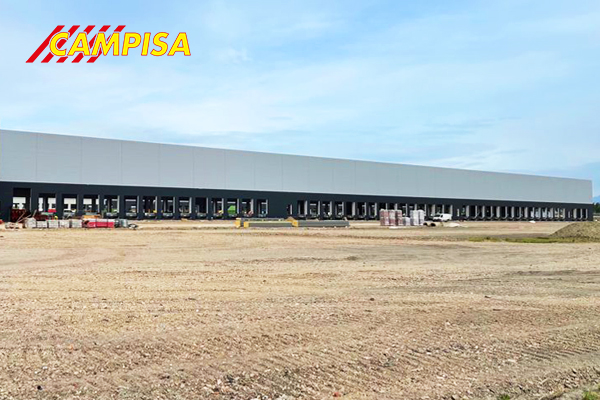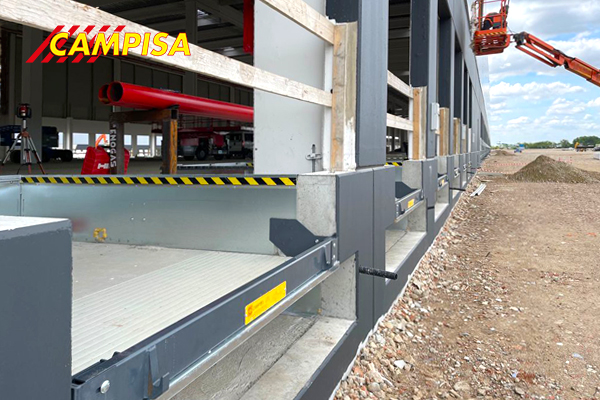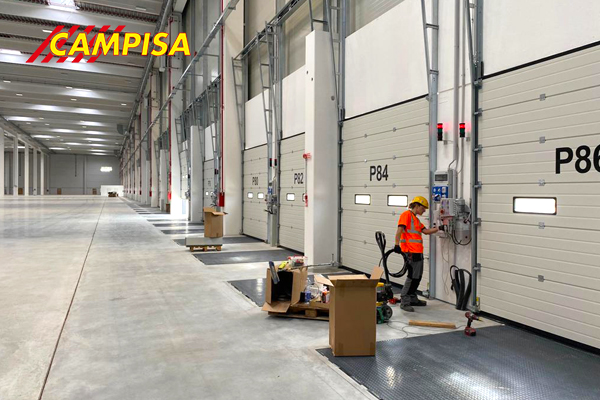Complete guide for setting up Campisa loading points

In the last interview on the Campisa blog (click here if you haven’t read it yet) we asked our technicians how the production process of our loading and unloading bays and inlets develops : from the first contact with the customer, through design, production and logistics, up to assembly on site.
With today’s article, we focus on this last point, drawing up a guide for setting up loading points in a logistics hub or industrial warehouse.
LOADING BAYS: THE GUIDE TO SETTING UP LOGISTICS HUBS
All the key points that define the preparation of a loading and unloading dock are listed below.
PREMISE
Before starting, it is necessary to specify that during the preliminary design phases, a series of assessments must be carried out based on the type of warehouse or logistics hub on which the loading docks will be installed.
For this reason, the starting point is the identification of the vehicles that will pass through the goods loading and unloading area.
Vehicles are not all the same and their characteristics can change according to the goods to be transported: fresh, frozen, dry products, light groupage and various other types of goods.
Furthermore, trucks have different dimensions both in length and in height and this factor strongly affects the design of a dock, which must take into account all these aspects, in order to avoid huge future damages in case of incorrect design.
Summarizing what has been said so far, before proceeding with the design and construction of one or more loading bays, it is necessary to consider:
- What are the vehicles that will pass through the logistics hub.
- Evaluate the type of quay best suited to the logistical needs.
SIZE OF THE SQUARE
The second aspect to consider is the size of the installation yard , through which the vehicles pass to dock at the loading docks.
Taking into account the type of vehicle, it is necessary to evaluate that:
- If the vehicles are all the same, all the loading and unloading pits will be designed with the same layout.
- If the vehicles are not all the same, each loading point will have to be different and designed on the basis of the dimensions of the vehicles that will dock.
Therefore, on the basis of the vehicles in transit, it will be possible to determine the entire layout of the loading points, to guarantee efficient and totally safe logistics flows.
CHOICE OF EQUIPMENT
After carrying out the preliminary analyzes and measuring the dimensions of the logistics hub, the equipment for the loading bays is chosen.
Loading points are generally composed of: loading ramp, sectional door, sealer and bumper
Based on the type of business, our catalog offers numerous solutions specially developed to meet the customer’s needs, solving all the hidden problems on site.
Also with regard to the cold chain, Campisa’s recessed loading bays are designed to ensure maximum insulation and insulation to maintain thermal control during the handling of fresh and frozen products.
PRODUCTION OF EQUIPMENT FOR LOADING AND UNLOADING BAYS
After establishing together with Campisa technicians all the components that will make up the new logistics hub, the production process begins in our factories in Piedmont.
Thanks to the use of certified materials, the use of technological machinery and advanced construction techniques, our products are ready to satisfy any expectation and are shipped to the construction site to be installed in the shortest possible time.
ASSEMBLY OF THE PREFABRICATED PIT
The Prefabricated Pit is a flagship of Campisa. It is proposed as an alternative to traditional construction pits which require high costs and long construction times.
The Fossa is directly installed in its predisposition without any invasive building intervention and is immediately ready to welcome the loading ramp.

INSTALLATION OF LOADING RAMPS
The next phase is the installation of the hydraulic loading and unloading ramps and platforms above the Prefabricated Pit.
Available in different types and models, all Campisa loading ramps are made with the best structural steel and painted with epoxy powder to ensure maximum durability over time, resisting rust.
Thanks to their simple and advanced structure, installation takes place quickly and they can also be adapted to different pit construction systems (the ideal solution for those who need to replace old loading and unloading ramps).
SECTIONAL DOOR ASSEMBLY
The fundamental element for closing the loading dock is undoubtedly the sectional door, which divides and separates the external environment from the inside of the building where the temperature must be kept as constant as possible.
Campisa sectional doors guarantee maximum insulating power and are the perfect solution for separating and insulating rooms in the cold chain.
Available in both spring-balanced and motorized versions, Campisa loading bay closures are quickly installed, combining perfectly with the loading ramp without encumbrance.
In this way, operators can transit on the quay quickly and without the danger of obstacles on the ground, often caused by obsolete closures.
INSTALLING THE FIDELITY CONSOLE
Fidelity is the Campisa patent that distinguishes us from the competition . Thanks to this electro-hydraulic system mounted in a simple and intuitive control console, operators can operate the loading ramp and the sectional door simultaneously in complete safety and with maximum speed
Fidelity is simply installed inside the building and combines a ramp and a door.

FIXING OF SEALANTS
Sealants are the essential element of a loading bay to ensure thermal insulation and protection of the goods while docking the vehicle in the loading tunnels.
The isothermal gantries are made with the best PVC sheets supported by a solid and robust carpentry structure, capable of withstanding any impact.
They are installed outside the quay and adapt to any type of vehicle and company context.
ACCESSORIES FOR SAFETY ON LOADING BAYS
Once the installation of the pit, loading ramp, sectional door, FIdelity and isothermal portal has been completed, we proceed with the assembly of the safety accessories.
Here, loading dock bumpers are the number one tool that absorbs the shocks of rearing vehicles, protecting the loading dock.
The bumpers are installed directly on the platform at the height of the vehicle floor to stop it in the event of an impact.
Other accessories are also available which are defined in the design phase. Click here to discover them all.
EXTERNAL QUAYS: SOLUTIONS WITHOUT BUILDING WORK
How do I create a loading point if I cannot intervene with building works?
We’ll give you the answer: the Dock Houses.
This type of loading pit was developed for those who cannot do masonry work and must create loading points for trucks outside the factory.
Campisa Dock Houses are real loading docks made up of a prefabricated dock with ramp, door and sealant.
They are installed directly off the quay and require no building work.
Click here to read all the features and find out the prices of the external loading docks.
LOADING BAY DESIGN: THAT'S WHY CHOOSING CAMPISA
For over 50 years we have been a world leader in the supply of the best equipment for loading and unloading ports .
Our presence in the world allows us to interface with the best players in the logistics landscape every day and develop the best logistics solutions together with them.
Put us to the test too! Book a free consultation with one of our technicians and create the new loading docks for your company with us.
Use the contact form below or call us toll-free.
We are ready to meet your expectations.



